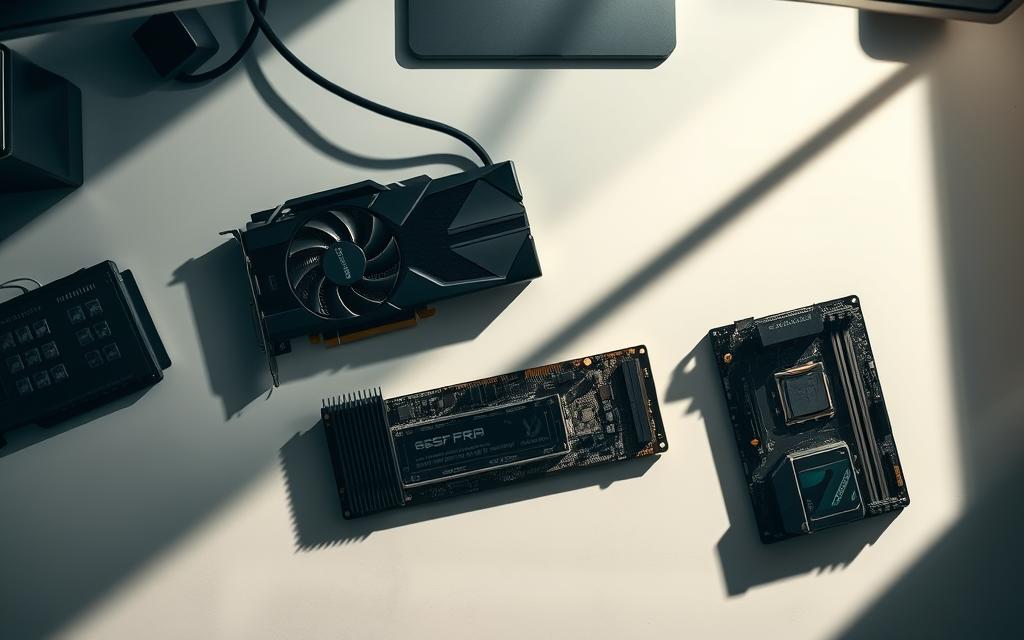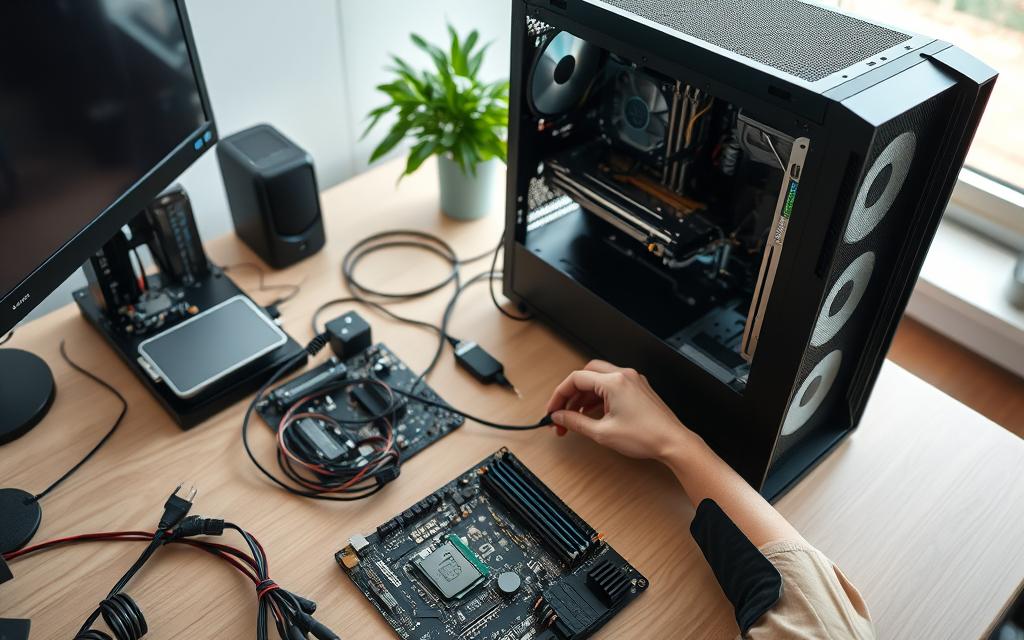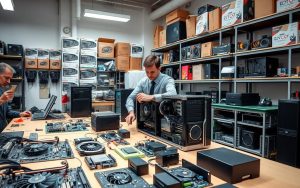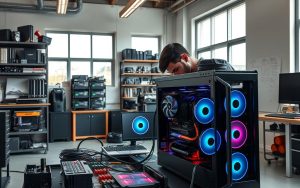Table of Contents
The demand for custom systems continues to grow, driven by gamers, professionals, and tech enthusiasts. These groups often seek tailored solutions that meet their specific needs. Combining technical expertise with a solid strategy is essential for success in this competitive field.
Established manufacturers like Dell and HP dominate the market, but niche specialization offers a unique edge. Companies such as Vision Computers and Total Data Solutions have carved out successful paths by focusing on premium services and high-quality builds. Specializing in areas like gaming rigs or professional workstations can set you apart.
Staying updated with technology trends is crucial. For example, the Corsair Elite Build Kit provides a solid foundation for mid-range systems, while GPU pricing, like the RTX 4070 Ti, remains a key consideration. Tools like magnetic screwdriver kits and anti-static equipment are also vital for efficient operations.
Warranty management and strong vendor relationships further enhance your reputation. By offering reliable service and leveraging market insights, you can thrive in this dynamic industry. For more detailed guidance, check out this resource on starting a custom PC venture.
Introduction to the PC Building Business
The custom PC industry is booming, with annual valuations exceeding $10 billion. This growth is fueled by a shift from traditional hardware sales to service-based revenue models. Companies like Total Data Solutions have successfully transitioned, now generating 85% of their income from services like maintenance and upgrades.
Essential tools for this business include anti-static workstations and component testing equipment. These ensure high-quality builds and minimize errors. Additionally, psychological testing for customer service staff, as practiced by Vision Computers, enhances client satisfaction and loyalty.
Legal requirements are a critical aspect. Reseller tax IDs and state registrations are mandatory. Resources from SBA.gov can guide you through compliance. Startup costs typically range from $5,000 to $20,000, depending on scale and location.
Success in this field hinges on technical expertise, exceptional customer service, and a niche focus. Emerging opportunities in AI workstation builds and edge computing offer exciting prospects for growth.
| Startup Costs | Critical Success Factors |
|---|---|
| $5,000 – $20,000 | Technical Expertise |
| Anti-static Workstations | Customer Service |
| Component Testing Equipment | Niche Focus |
Combining passion for technology with a strategic approach can set you apart in this competitive market. By focusing on tailored systems and reliable services, you can carve out a successful path in the custom PC industry.
Understanding the Market for Custom PCs
The custom PC market thrives on innovation and specialization. Identifying your target audience and analyzing competitors are critical steps to succeed in this dynamic industry.

Identifying Your Target Audience
Understanding who needs custom PCs is essential. Gamers, professionals, and tech enthusiasts are the primary groups driving demand. Each group has unique requirements, from high-performance gaming rigs to powerful workstations.
Focusing on niche segments, such as AI workstation builds or edge computing, can help you stand out. Tailoring your product offerings to meet these specific needs ensures customer satisfaction and loyalty.
Analyzing Competitors
Major players like Dell Alienware, HP Omen, and NZXT BLD dominate the market. However, boutique builders often differentiate themselves through unique offerings like custom water cooling and bespoke case mods.
Conducting a SWOT analysis helps identify strengths and weaknesses. Monitoring reviews on platforms like Newegg and Amazon provides valuable insights into competitor performance and customer preferences.
Partner programs from AMD and NVIDIA offer additional advantages for system integrators. Counter-strategies, such as extended warranties and white-glove assembly, can further enhance your competitive edge.
Essential Skills for PC Building
Mastering the art of assembling custom systems requires a blend of technical knowledge and strategic thinking. Whether you’re targeting gamers, professionals, or tech enthusiasts, success hinges on balancing hands-on expertise with effective business practices.
Technical Expertise
Building high-performance systems starts with a deep understanding of components and compatibility. Financial planning is crucial; conducting a COGS analysis for $2,000 builds ensures profitability. Implementing a CRM system streamlines client management, while inventory strategies like JIT or bulk purchasing optimize operations.
Tools like Stripe or PayPal simplify payment processing, ensuring smooth transactions. Drafting contracts for enterprise clients and understanding insurance requirements, such as general liability and E&O, further safeguard your operations.
Business Acumen
Beyond technical skills, a strong business mindset is vital. Tax considerations, including depreciation schedules and R&D credits, can significantly impact your bottom line. Pricing strategies tailored to B2B or B2C markets ensure competitiveness and profitability.
By combining technical expertise with strategic business practices, you can deliver exceptional services and build a sustainable business. This dual focus sets the foundation for long-term success in the custom PC industry.
How to Get Into the PC Building Business
Starting a venture in the custom systems industry requires careful planning and execution. A well-thought-out strategy ensures efficiency and long-term success. From workspace setup to workflow optimization, every detail matters.

Creating a Business Plan
A robust business plan is the foundation of any successful operation. It outlines your goals, target audience, and financial projections. Consider the following elements:
- Market Analysis: Identify your niche, whether it’s gaming rigs or professional workstations.
- Financial Planning: Calculate startup costs, including tools and inventory.
- Operational Strategy: Define your workflow and assembly line efficiency.
Setting Up Your Workspace
An organized workspace is crucial for productivity and safety. Here’s what you’ll need:
- ESD-Safe Workstation: Use anti-static mats and wrist straps to protect sensitive components.
- Tool Organization: Magnetic trays and labeled bins keep everything in place.
- Inventory Storage: Anti-moisture cabinets ensure components remain in optimal condition.
Compliance with OSHA electrical safety standards is non-negotiable. Additionally, a well-designed showroom enhances client presentations, while security measures like surveillance cameras protect your assets.
By focusing on these aspects, you can create a streamlined and efficient operation. This way, you’ll save time and deliver high-quality results to your clients.
Choosing the Right Components
Selecting the right components is the backbone of any successful custom system. High-quality parts ensure performance, reliability, and customer satisfaction. From motherboards to power supplies, each piece plays a critical role in the final product.

Understanding Compatibility
Compatibility is key when assembling a custom system. The motherboard must match the CPU socket type, and the power supply should meet the wattage requirements of all installed parts. Memory modules, such as DDR4 or DDR5, must align with the motherboard’s QVL (qualified vendor list).
For example, a high-performance CPU may require a liquid cooling system, while the case must support the motherboard’s form factor. Tools like PCMag’s guide can help you navigate these complexities.
Sourcing Reliable Suppliers
Partnering with trustworthy suppliers ensures consistent quality and timely delivery. Consider these factors when choosing a company:
- Distributor Vetting: Compare options like Ingram Micro and Synnex for competitive pricing and service.
- MOQ Negotiations: Small businesses can benefit from flexible minimum order quantities.
- RMA Process: Opt for suppliers with efficient cross-shipment strategies for returns.
Local partnerships, such as those with Micro Center, offer additional advantages like faster shipping and reduced tariffs. Always verify component authenticity to avoid counterfeit parts.
Building Your First PC
Assembling a custom system for the first time can be both exciting and challenging. Proper preparation ensures a smooth process and minimizes errors. Gathering the right tools and following a step-by-step guide will save you time and effort.

Tools You’ll Need
Having the right tools is essential for a successful build. Here’s a list of items you’ll need:
- Magnetic Screwdriver: Prevents screws from getting lost during assembly.
- Anti-Static Wrist Strap: Protects sensitive components from static discharge.
- Thermal Paste: Ensures proper heat transfer between the CPU and cooler.
- Cable Ties: Helps manage and organize cables for better airflow.
| Tool | Purpose |
|---|---|
| Magnetic Screwdriver | Secure screws without losing them |
| Anti-Static Wrist Strap | Protect components from static |
| Thermal Paste | Improve CPU cooling efficiency |
| Cable Ties | Organize cables for better airflow |
Step-by-Step Assembly Process
Follow these steps to assemble your system efficiently:
- Install Motherboard Standoffs: Secure the motherboard to the case using standoffs to prevent short circuits.
- Align CPU Markers: Use the triangle indicators to correctly place the CPU in the socket.
- Optimize Memory Channels: Insert RAM sticks into slots A2 and B2 for dual-channel performance.
- Attach M.2 Heatsink: Ensure the M.2 SSD is properly cooled with a heatsink.
- Connect Front Panel Headers: Carefully attach power, reset, and LED cables to the motherboard.
- Route PSU Cables: Organize cables for better airflow and aesthetics.
- Configure BIOS: Adjust settings during the first boot for optimal performance.
- Run Stress Tests: Use tools like Prime95 and FurMark to ensure system stability.
By following this way, you’ll build a reliable and high-performance system. Patience and attention to detail are key to a successful first build.
Pricing Your Custom PCs
Pricing custom systems effectively is a critical step in establishing a profitable operation. Balancing costs and profit margins ensures sustainability while meeting customer expectations. Companies like Vision Computers and Total Data Solutions have set benchmarks with their premium services and tailored pricing strategies.
Cost Analysis
Understanding your expenses is the foundation of pricing. Industry-standard margins for custom builds range from 20% to 35%. This includes costs for components, labor, and overhead. For specialized systems, value-based pricing can justify higher rates.
Subscription models for maintenance plans offer recurring revenue streams. Upselling opportunities, such as extended warranties, enhance profitability. Monitoring competitor pricing using tools like Price2Spy ensures you stay competitive in the market.
Setting Profit Margins
Dynamic pricing strategies are essential for rare or high-demand components. Non-profit pricing for educational institutions can build goodwill and long-term relationships. Clearance sales for obsolete inventory help recover costs and free up storage space.
Vision Computers’ approach to premium pricing highlights the importance of quality and support. Total Data Solutions’ service contracts demonstrate the value of long-term client commitments. Both strategies emphasize transparency and customer satisfaction.
| Pricing Strategy | Benefits |
|---|---|
| Value-Based Pricing | Justifies higher rates for specialized systems |
| Subscription Models | Provides recurring revenue |
| Dynamic Pricing | Adjusts for rare or high-demand components |
| Non-Profit Pricing | Builds goodwill with educational institutions |
By implementing these strategies, you can create a pricing model that supports your business goals while delivering value to your customers. A well-structured approach ensures long-term success in the competitive custom PC industry.
Marketing Your PC Building Business
Effective marketing strategies are essential for standing out in the competitive custom systems industry. Building a strong brand presence and forming strategic partnerships can significantly boost your visibility and customer base. Vision Computers’ partnership strategies highlight the importance of premium services and tailored solutions.
Building an Online Presence
A robust online presence is critical for reaching your target audience. Start by creating a professional website that showcases your expertise and portfolio. Utilize social media platforms like Instagram and Twitter to engage with tech enthusiasts and gamers. Regularly post content, such as build tutorials and component reviews, to establish authority in the field.
Search engine optimization (SEO) ensures your website ranks high on Google. Tools like Google Analytics help track visitor behavior and refine your strategy. Email marketing campaigns can keep your audience informed about new products and promotions.
Networking and Partnerships
Forming alliances with local businesses, such as LAN centers and universities, can expand your reach. Component manufacturer certification programs, like those offered by NVIDIA and AMD, add credibility to your company. Participating in trade shows like PAX and CES provides exposure to a broader audience.
Referral programs for IT consultants and co-marketing with gaming influencers can drive sales. Channel partnerships with software vendors and OEM agreements for bulk licensing offer additional revenue streams. Charity builds for community visibility enhance your brand’s reputation and foster goodwill.
“Strong support systems ensure customer satisfaction and long-term loyalty.”
By combining online marketing efforts with strategic partnerships, you can create a sustainable and profitable business. These approaches not only increase visibility but also build trust with your audience.
Customer Service and Support
Exceptional customer service is the backbone of any successful operation in the custom systems industry. Addressing client concerns promptly and professionally builds trust and strengthens relationships. A well-structured support system ensures long-term satisfaction and loyalty.
Handling inquiries efficiently is a critical part of the process. Implementing a CRM system helps track and resolve issues quickly. Training your team to handle technical questions and provide clear solutions enhances the overall client experience.
Offering comprehensive warranty options is another key aspect. Three-year models, including basic and premium tiers, provide clients with peace of mind. On-site and depot repair options cater to different needs, while loaner systems minimize downtime during repairs.
Tracking component failure rates helps identify recurring issues and improve product quality. Insurance requirements for technicians ensure safety and compliance. End-of-life component notifications and software update maintenance plans keep clients informed and their systems up-to-date.
“Strong support systems ensure customer satisfaction and long-term loyalty.”
Disaster recovery services offer additional value, especially for enterprise clients. By addressing these areas, you can create a reliable and efficient support framework that sets your business apart in a competitive market.
Scaling Your PC Building Business
Growing a custom systems venture requires strategic planning and adaptability. As your operations expand, focusing on product diversification and team development becomes essential. Companies like Vision Computers have demonstrated the importance of structured growth in this competitive industry.
Expanding Your Product Line
Diversifying your offerings can attract a broader audience. Consider adding specialized systems, such as AI workstations or edge computing solutions. These niche products cater to specific client needs and set your business apart from competitors.
Subscription-based maintenance plans and upgrade packages provide recurring revenue streams. Partnering with component manufacturers for exclusive deals can also enhance your product portfolio. Always stay updated with emerging technologies to remain competitive.
Hiring and Training Staff
Building a skilled team is crucial for scaling your operations. Recruitment channels like trade schools and online forums such as Reddit can help you find talented individuals. Technical certifications, such as those from NVIDIA or AMD, ensure your team meets industry standards.
Implementing structured training programs, including assembly line simulations and customer service role-playing, enhances efficiency. Performance metrics, such as units assembled per day, help track progress and identify areas for improvement.
Employee retention strategies, like continuing education budgets and succession planning, foster loyalty and long-term growth. As Vision Computers has shown, investing in your team pays dividends in the form of consistent quality and client satisfaction.
“A skilled and motivated team is the backbone of any successful scaling effort.”
By focusing on product diversification and team development, you can create a scalable and sustainable business. These strategies ensure you remain competitive while delivering exceptional services to your clients.
Legal and Financial Considerations
Navigating the legal and financial landscape is crucial for long-term success in the custom systems industry. Proper planning ensures compliance, minimizes risks, and supports sustainable growth. Addressing these aspects early on prevents costly mistakes and sets a solid foundation for your venture.
Registering Your Business
Registering your venture is the first step toward legitimacy. Choose a business structure, such as an LLC or corporation, that aligns with your goals. Filing for a reseller tax ID and state registration ensures compliance with local laws. Tools like LegalZoom simplify the process, saving time and effort.
Accounting software, such as QuickBooks or FreshBooks, helps manage finances efficiently. Rosenthal’s shipping cost warnings highlight the importance of budgeting for logistics. By staying organized and compliant, you can focus on delivering exceptional services to your clients.
Managing Finances
Effective financial management is essential for profitability. Implement cash flow management techniques to ensure liquidity. Component depreciation schedules and R&D tax credit qualifications can significantly impact your bottom line. Chargeback prevention strategies safeguard your revenue streams.
Selecting the right merchant account ensures smooth processing of payments. Audit preparation checklists and investor reporting requirements maintain transparency. Exit valuation calculations provide insights into your venture’s worth, supporting strategic decisions.
| Financial Aspect | Key Strategy |
|---|---|
| Cash Flow Management | Ensure liquidity for operations |
| Component Depreciation | Optimize tax benefits |
| Chargeback Prevention | Protect revenue streams |
| Merchant Account Selection | Streamline payment processing |
By addressing these legal and financial considerations, you can build a resilient and profitable business. A well-structured approach ensures compliance, efficiency, and long-term success in the competitive custom systems industry.
Conclusion
Success in the custom systems industry hinges on niche focus and technical excellence. Staying ahead of trends like AIO liquid cooling and PCIe 5.0 adoption ensures your business remains competitive. Start small, validate demand, and scale strategically.
Resources like SBA mentorships and CompTIA training provide valuable support. Create your first build portfolio to showcase your skills and attract clients. The industry is projected to grow at a 7% CAGR through 2030, offering ample opportunities for growth.
Veterans in the field emphasize the importance of passion and persistence. Join builder communities to network, learn, and share experiences. This way, you’ll stay inspired and informed.
This guide offers a roadmap to navigate the challenges and rewards of the custom systems industry. With dedication and the right strategies, you can carve out a successful path in this dynamic field.
FAQ
What skills are essential for starting a custom PC business?
You’ll need technical expertise in assembling components like motherboards, processors, and graphics cards. Business acumen is also crucial for managing finances, marketing, and customer relations.
How do I identify my target audience in the custom PC market?
Focus on niches like gaming, video editing, or high-performance systems. Analyze customer needs and preferences to tailor your builds and services effectively.
What tools are necessary for building custom PCs?
Essential tools include screwdrivers, anti-static wristbands, and thermal paste. You’ll also need testing equipment to ensure system stability and performance.
How do I source reliable components for my builds?
Partner with trusted suppliers like Newegg, Amazon, or direct manufacturers. Research reviews and warranties to ensure quality and compatibility.
What steps are involved in pricing custom PCs?
Start with a cost analysis of components, labor, and overhead. Set profit margins based on market rates and competitor pricing to remain competitive.
How can I market my custom PC business effectively?
Build an online presence through a professional website and social media. Network with tech communities and form partnerships to expand your customer base.
What legal steps are required to start a PC building business?
Register your business, obtain necessary licenses, and set up proper financial systems. Consult a legal expert to ensure compliance with local regulations.
How do I handle customer inquiries and support?
Provide clear communication channels like email or live chat. Offer warranties and troubleshooting guides to build trust and ensure customer satisfaction.
What are the key considerations for scaling my business?
Expand your product line with new systems or upgrades. Hire and train staff to manage increased demand while maintaining quality and service standards.









